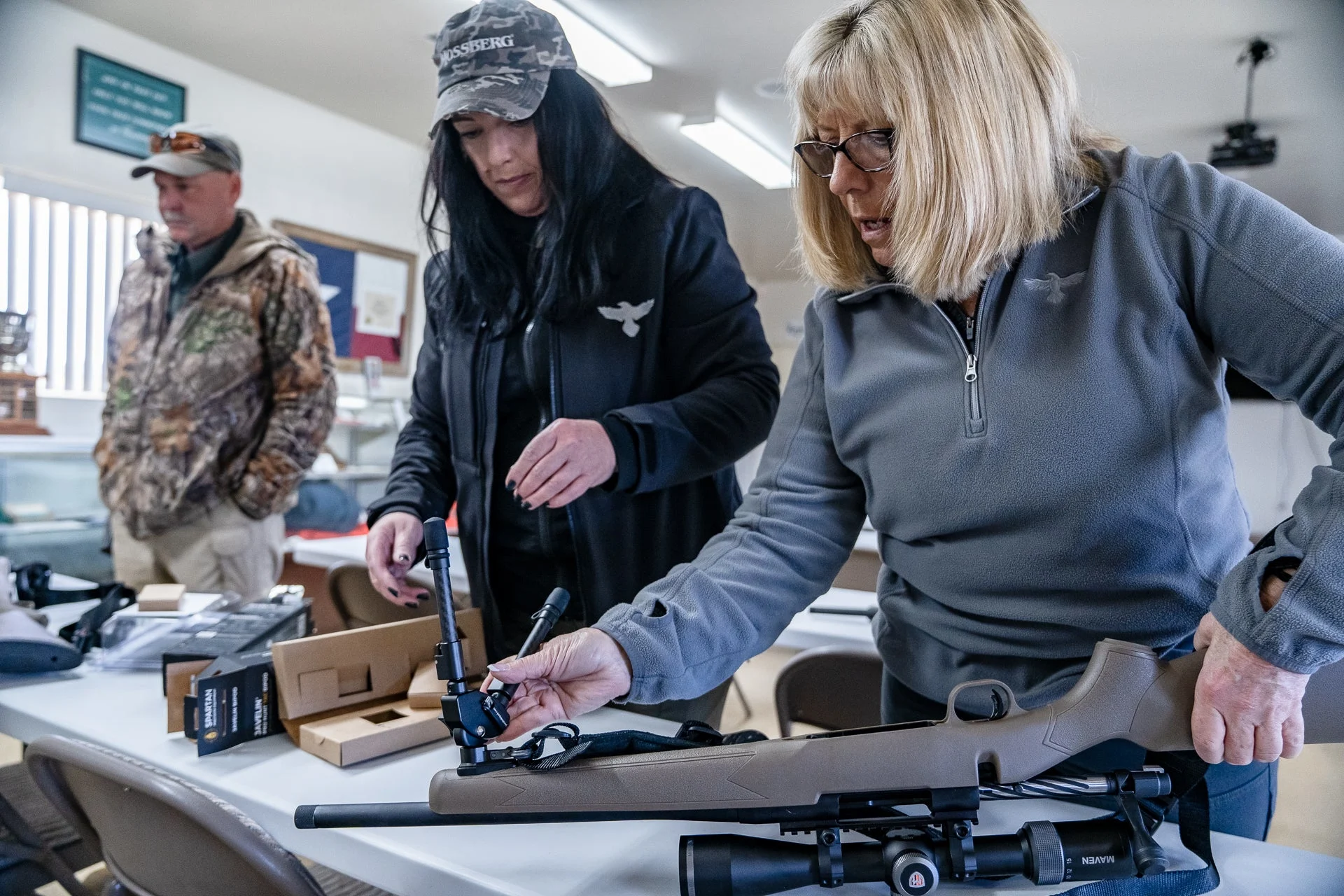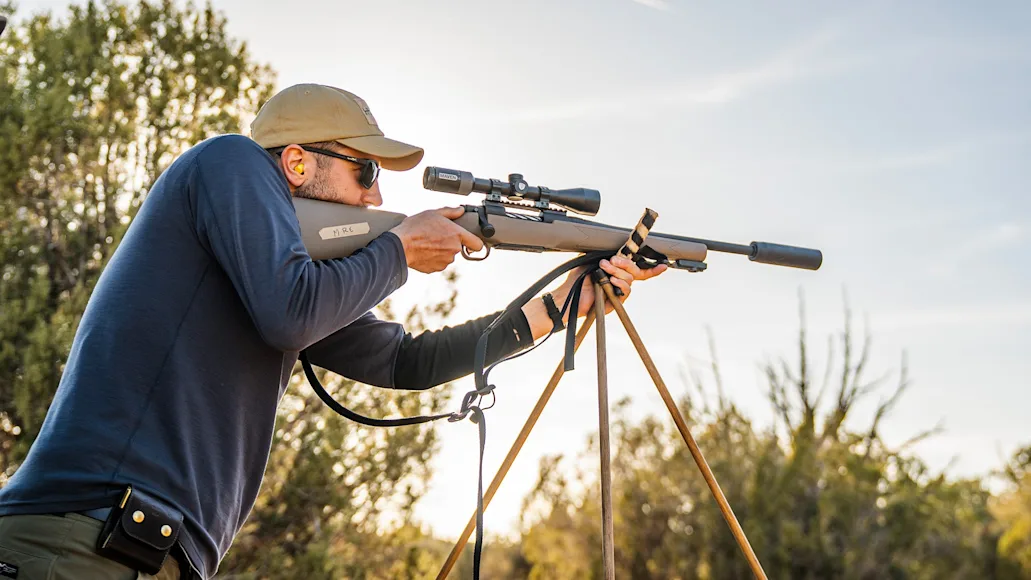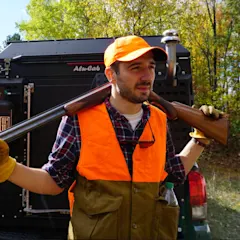_We may earn revenue from the products available on this page and participate in affiliate programs. Learn more ›
_
Gunsite shooting instructors have seen it all. Most have a lifetime of shooting experience themselves, and they train hundreds of people of varying skill levels every year. According to these experts, most hunters are about 30 percent ready when they step onto the range at Gunsite for a course like Hunter Prep, The 270 Rifle Class, or private instruction. This past winter, I was one of those hunters in a Safari Prep course, and I definitely learned a thing or two shooting with instructors Dave Hartman and Gary Smith.
As hunters, we tend to think of ourselves as pretty good shots, and most of us have antlers on the wall to prove it. But, like many skills, shooting is full of pitfalls that get deeper when you don’t practice. Hartman and Smith are both hunters themselves, but more important, they’re teachers. They’ve seen just about every mistake a hunter can make when it comes to rifle shooting. Here are the five most common—and how to fix them

Learn how to get the all-new Field & Stream journal!
Mistake No. 1: Misjudging Range—and Your Shooting Ability
With high-tech optics, range finders, and super-accurate rifles, it’s easy to get carried away with how far you think you can shoot. But hunting isn’t the place to wing it. “Hunting is about making an ethical shot, and to me an ethical shot is a shot you can make 100 percent of the time,” Smith says. “In general, 200 yards is where we start seeing most shooters fall apart.”
Hunters can have trouble inside of 200 yards, too. Smith told a story of someone he was guiding who missed an elk at 35 yards, for example. The key is to have an accurate gauge on your ability before you get into the field
. You also need to know how to judge distance should you misplace your rangefinder or need to make a quick shot.

Instructor Gary Smith drops some knowledge on the author and his classmates. Sabastian “Bat” Mann
Smith and Hartman suggest practicing range estimation and confirming that with a rangefinder until you get good. They also suggest using a 200-yard zero so that anything you see within 200 yards, you can shoot without dialing a turret. To get a better idea of how far you can shoot beyond that, practice at different distances and shooting positions. If you can’t hit a target 100 percent of the time at a given distance, you have no business shooting an animal that far.
Mistake No. 2: Lacking an Understanding of Marksmanship Fundamentals
Most hunters could be better at getting in an out of shooting positions. This is surprising because out of anyone who shoots a firearm, hunters are the most likely to be away from a shooting bench. Still, that’s where we do most of our practice.
“You need to get off the bench and shoot more,” says Hartman “Once you get your rifle sighted in, get off the bench.” In my Safari Prep course, we never touched a shooting bench. We shot standing, seated, kneeling, and prone. Both Smith and Hartman suggest incorporating these positions into your range sessions. Along with that, the instructors also see problems with how hunters use their optics.
“The biggest problem I see is hunters focused on the animal or target rather than their reticle,” Smith says. It might sound strange, but focusing on your crosshair—not the animal—as you pull the trigger will improve your ability to hit a target.
It’s also important to learn how to trust the wobble you see in your reticle. “Our bodies are never perfectly still,” Smith says. With a stable field position, your crosshair will move a bit, but all of that movement should be within the kill zone of your target and consistent. If it is, focus on the reticle and pull the trigger. Whatever you do, don’t try to time your shot for when your reticle crosses over the perfect spot on your target. If you do, you’ll probably jerk the trigger and move your gun off target.

Once you zero your rifle, you should get off of the shooting bench and practice from positions you’re mostly likely to use in the field, including offhand. Sabastian “Bat” Mann
Mistake No. 3: Not Shooting Enough
We all know hunters who’ve been slowly working their way through one box of ammo for years. They take their rifle out during deer season, take one or two shots, then put it away for the rest of the year. That works until it doesn’t. Shooting is a perishable skill that requires practice. The trouble is, practice is expensive, especially when you’re talking about shooting hunting ammo.
“I’m a big fan of the understudy rifle,” Hartman says. “For example, if you have a 300 Win Mag, buy a similar or the same model rifle in a smaller caliber. That way, you can get lots of range time for less money and less recoil.”
Many manufacturers today even make grown-up sized 22LR trainers of bigger rifles. Investing in one could save you a pile of money in ammunition should you want to practice more. And as we’ve covered before
, you don’t need a ton of ammo to get a good range session in. Shooting fewer rounds more frequently will keep you in good shape for deer season.
Smith also suggests that you can get better at shooting without live ammunition or going to the range. “A lot can be accomplished dry firing
,” he says. “When you go to the range, you’re just confirming that you’re doing your dry fire practice right.” Practice shooting positions, trigger press, and work on focusing on your reticle. Smith says a good way to tell if you’re dry firing correctly is that the gun shouldn’t move when you press the trigger.
**Related: 4 Perfect Dry Fire Drills for Hunters
**
Mistake No. 4: Believing that Better Gear Will Make You a Better Shooter
“A lot of people want to buy their way to bullseyes and X rings,” Hartmann says. “They’ll buy a $10,000 rifle and expect it to do all the work for them, and it doesn’t. I would suggest keeping it simple, then shoot up to the expectations of your equipment. You can always upgrade later.”

A simple setup like this Mossberg Patriot is all you need for most big-game hunting in North America. Sabastian “Bat” Mann
Hartman and Smith also suggest matching your equipment to your environment. For example, if you’re hunting around a lot of tall grass, you probably won’t be able to use your bipod because you won’t be able to see from the prone position. Gear is great, but learning fundamentals is better. It’s also better to make the most of the gear you have.
“Learn to use the sling for support,” says Hartman. “I was up in Prince of Whales Island last November for a blacktail hunt. I didn’t bother taking shooting sticks or a tripod with me because I know how to use braced kneeling and other positions with my sling.” The more you know about shooting, the less gear you’ll have to haul into the woods.
Mistake No. 5: Not Being Familiar Enough With the Gear You Have
A lot of hunters don’t have a good understanding of how their rifle works, or how to fix it in the field if something goes wrong. Time on the range will help with that. But going to a course like one you’ll find at Gunsite or shooting a match will go even further to expose any flaws your rifle, optic, or other gear may have.
“We just had a Hunter Prep course where a few of the shooters optics mounts came loose,” says Hartman. “Before going hunting, I’d make sure everything is Loc-Tited and torqued to the right specs. Check things like your sling swivels, too.”

Students at a Gunsite classroom get familiar with their equipment. Sabastian “Bat” Mann
“You also need to understand how to manipulate your rifle,” Smith says. That means simple things like how the safety works, how to reload, and field strip. While we were at Gunsite, we practiced things like loading single rounds into an empty rifle under pressure, checked if our rifle bolts locked when the safety was on, and made note of whether the suppressors we were using came loose after a number of shots. In the classroom, we spent time going through gear lists and coming up with things to pack to repair our rifles should we need to. If you don’t know how your rifle works, read the manual, go online, or sign up for a class like one you’ll find at Gunsite.


